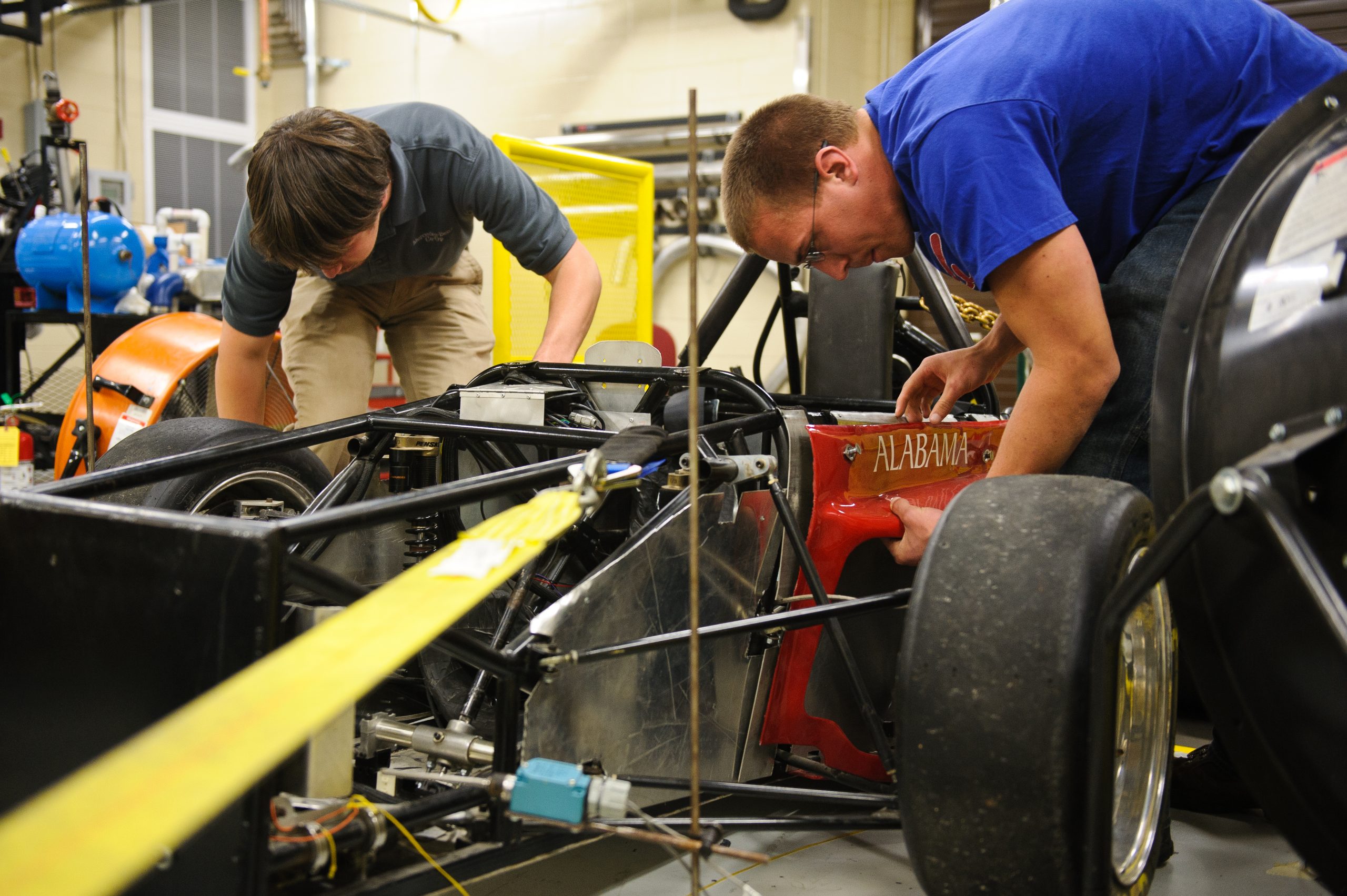
The College of Engineering offers several auto competition teams that allow students to learn engineering through hands-on experience. From left, Crimson Racing team members Cole Frederick, studying mechanical engineering, and Chris New, studying electrical and computer engineering, work on their car.
Ten years from now, cars and trucks will have more electronics and software than mechanical parts, which creates an opportunity for research and innovation.
“There is a dramatic shift in electrical drive and batteries, and with this move comes more questions we can research and analyze,” said Dr. Bharat Balasubramanian, executive director of the Center for Advanced Vehicle Technologies in the UA College of Engineering.
Analyzing and answering questions is at the base of academic research, and Balasubramanian, who retired in 2012 as vice president of group research and advanced engineering at Mercedes-Benz in Germany, said The University of Alabama must help the auto industry build the car of the future.
Part of the College’s research and academic focus is fixed on the auto industry, which has a heavy presence in Alabama and the Southeastern United States. Researchers from across the College have worked with companies to better understand or improve their products in hopes of benefiting industry and enhancing the educational experience for students.
“The auto industry in our state can use us to understand the science needed to make engineering advancements in their products,” said Dr. Gregory Thompson, a professor of metallurgical and materials engineering. “We can add value to being in Alabama.”
“To keep the industry flourishing in our state and region we need an ecosystem between education, applied research and industrial projects to attract and keep the students and preserve the competitive advantage of the Southeastern U.S. over lower-cost countries such as Mexico and China.”
– Dr. Bharat Balasubramanian
Thompson’s work is an example of the breadth of research auto manufacturers and their suppliers can call upon from academia. With a state grant from the Alabama Innovation Fund, Thompson worked with Nucor Steel–Decatur in developing next-generation, low-alloy, high-strength steels that would eventually be used in auto manufacturing.
For the project, Thompson was able to use the University’s Local Electrode Atom Probe, or LEAP, essentially a powerful microscope that shows the location and distribution of atoms in various materials. Looking at the steel under the atom probe helped Nucor understand the properties of the alloys, which can be used to further improve the steel.
“They’ve been making these steels, but they haven’t had the level of detailed characterization and scientific investigation to understand all the factors that contribute to its good properties,” Thompson said. “Once you understand something, then you can engineer it.”
Along with providing scientific understanding, academic researchers can save companies time and resources on testing. Dr. Mark Barkey, a professor of aerospace engineering and mechanics, has worked on projects with auto makers like GM and Ford and, most recently, he was contacted by Chrysler to investigate the stress rubber engine mounts can handle with temperature.
“Companies want to do a lot more computer-aided engineering, and they need to have data for that,” Barkey said. “Computer simulations help them to reduce the amount of testing, which can be very expensive. Now they’re just looking for that extra edge … those data that will help them design their cars.”
Dr. Samit Roy, the William D. Jordan Professor of Aerospace Engineering and Mechanics, is also using computers to quicken testing for an auto company. He and his students work with Mercedes-Benz U.S. International to help perfect a new riveting-welding method.
This method can save manufacturers both time and money, but because it’s new, manufacturers do not yet fully understand the mechanical behavior of the rivet joints from a quality control point of view. So, researchers, such as Roy, are generating data to help manufacturers better estimate the strength and reliability of the rivet connections.
Rather than physically damage sheets of metal in testing, Roy and his students gather data using a sophisticated computer-simulation program as an alternative to destructive testing.
Balasubramanian has worked with Mercedes to secure research partnerships to help engineer tomorrow’s technology, including a project to better manage the state of charge and state of health in vehicle batteries.
Dr. Jaber Abu Qahouq, an associate professor of electrical and computer engineering, is working with Mercedes to find out how some battery cells degrade faster than others, which is a problem because batteries are only as good as their weakest cells. With batteries being expensive parts of electric vehicles, extending their lives could make the technology more affordable, Balasubramanian said.
But assisting the auto industry is more than research, Balasubramanian said. He and others in the College are working to beef up curriculum that prepares students to engineer future vehicles.
Balasubramanian said he hopes the curriculum, when combined with sponsored research and internships, will help UA attract to-flight students into the auto industry in the Southeast.
It’s a course he believes UA and other institutions in the South must pursue.
“To keep the industry flourishing in our state and region we need an ecosystem between education, applied research and industrial projects to attract and keep the students and preserve the competitive advantage of the Southeastern U.S. over lower-cost countries such as Mexico and China,” he said.